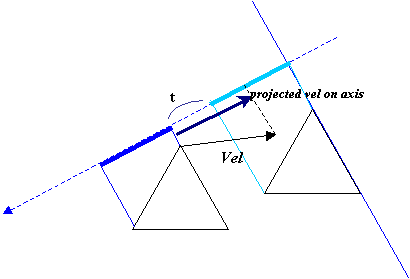| bool Collide( const Vector* A, int Anum,
const Vector* B, int Bnum,
const Vector& xOffset, const Vector& xVel,
Vector& N, float& t)
{
if (!A || !B) return false;
// All the separation axes
// note : a maximum of 32 vertices per poly is supported
Vector xAxis[64];
float taxis[64];
int iNumAxes=0;
xAxis[iNumAxes] = Vector(-xVel.y, xVel.x);
float fVel2 = xVel * xVel;
if (fVel2 > 0.00001f)
{
if (!IntervalIntersect( A, Anum, B, Bnum, xAxis[iNumAxes], xOffset, xVel, taxis[iNumAxes], t))
return false;
iNumAxes++;
}
// test separation axes of A
for(int j = Anum-1, i = 0; i < Anum; j = i, i ++)
{
Vector E0 = A[j];
Vector E1 = A[i];
Vector E = E1 - E0;
xAxis[iNumAxes] = Vector(-E.y, E.x);
if (!IntervalIntersect( A, Anum, B, Bnum, xAxis[iNumAxes], xOffset, xVel, taxis[iNumAxes], t))
return false;
iNumAxes++;
}
// test separation axes of B
for(int j = Bnum-1, i = 0; i < Bnum; j = i, i ++)
{
Vector E0 = B[j];
Vector E1 = B[i];
Vector E = E1 - E0;
xAxis[iNumAxes] = Vector(-E.y, E.x);
if (!IntervalIntersect( A, Anum, B, Bnum, xAxis[iNumAxes], xOffset, xVel, taxis[iNumAxes], t))
return false;
iNumAxes++;
}
if (!FindMTD(xAxis, taxis, iNumAxes, N, t))
return false;
// make sure the polygons gets pushed away from each other.
if (N * xOffset < 0.0f)
N = -N;
return true;
} |
| bool AxisSeparatePolygons ( Vector N, Polygon A, Polygon B, Vector Offset, Vector Vel, float &t, float tmax)
{
float min0, max0;
float min1, max1;
CalculateInterval(N, A, min0, max0);
CalculateInterval(N, B, min1, max1);
float h = Offset dot N;
min0 += h;
max0 += h;
float d0 = min0 - max1; // if overlapped, do < 0
float d1 = min1 - max0; // if overlapped, d1 > 0
// separated, test dynamic intervals
if (d0 > 0.0f || d1 > 0.0f)
{
float v = Vel dot N;
// small velocity, so only the overlap test will be relevant.
if (fabs(v) < 0.0000001f)
return false;
float t0 =-d0 / v; // time of impact to d0 reaches 0
float t1 = d1 / v; // time of impact to d0 reaches 1
// sort the times.
if (t0 > t1)
{
float temp = t0;
t0 = t1;
t1 = temp;
}
// take the minimum positive
taxis = (t0 > 0.0f)? t0 : t1;
// intersection time too late or back in time, no collision
if (taxis < 0.0f || taxis > tmax)
return true;
return false;
}
else
{
// overlap. get the interval, as a the smallest of |d0| and |d1|
// return negative number to mark it as an overlap
taxis = (d0 > d1)? d0 : d1;
return false;
}
} |
|
bool FindCollisionPlane (Vector* Axis, float* taxis, int iNumAxes, Vector& Ncoll, float& tcoll)
{
// find collision first
int mini = -1;
tcoll = 0.0f;
for(int i = 0; i < iNumAxes; i ++)
{
if (taxis[i] > 0.0f)
{
if (taxis[i] > tcoll)
{
mini = i;
tcoll = taxis[i];
Ncoll = Axis[i];
Ncoll.Normalise(); // normalise axis
}
}
}
// found a collision
if (mini != -1)
return true;
// nope, find overlaps
mini = -1;
for(int i = 0; i < iNumAxes; i ++)
{
float n = Axis[i].Normalise(); // axis length
taxis[i] /= n; // normalise interval overlap too
// remember, those numbers are negative, so take the closest to 0
if (mini == -1 || taxis[i] > tcoll)
{
mini = i;
tcoll = taxis[i];
Ncoll = Axis[i];
}
}
return (mini != -1);
}
|






















 509
509











 被折叠的 条评论
为什么被折叠?
被折叠的 条评论
为什么被折叠?








